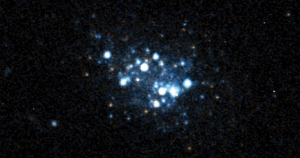
Newly Found Blue ‘Little Lion’ Galaxy May Reveal Secrets About Big Bang Theory
A research team from Indiana University (IU) have discovered a faint blue coloured galaxy about 30 million light-years away from Earth which is located in the constellation “Leo Minor.” The new findings could reveal could reveal more about the origin of our universe.
The galaxy nicknamed Leoncino, or “little lion,” has the lowest level of heavy chemical elements, or “metals” ever observed in a gravitationally bound system of stars. Experts believe that more analysis on Leoncino will reveal crucial details about the Big Bang and other conditions which prevailed in our galaxy.

“Finding the most metal-poor galaxy ever is exciting since it can help contribute to a quantitative test of the Big Bang,” said professor John J. Salzer from Indiana University in the US. “There are relatively few ways to explore conditions at the birth of the universe, but low-metal galaxies are among the most promising,” Salzer added.
The currently accepted model of the birth of the universe makes clear predictions about how much helium and hydrogen were present during the Big Bang, and the ratio of these atoms in metal-poor galaxies provides a direct test of the model. To find these low-metal galaxies, however, astronomers must look far from home.
According to space experts, any element other than hydrogen or helium is referred as metals. They believe that the elemental makeup of metal-poor galaxies is very close to that of the early Universe.
“Low metal abundance is essentially a sign that very little stellar activity has taken place compared to most galaxies,” said lead author Alec S Hirschauer, a graduate student at Indiana University.
Leoncino is considered a member of the “local universe,” a region of space within about 1 billion light years from Earth and estimated to contain several million galaxies, of which only a small portion have been catalogued.
A galaxy previously recognised to possess the lowest metal abundance was identified in 2005; however, Leoncino has an estimated 29 per cent lower metal abundance.
Aside from low levels of heavier elements, Leoncino is unique in several other ways. A so-called “dwarf galaxy,” it is only about 1,000 light years in diameter and composed of several million stars. The Milky Way, by comparison, contains an estimated 200 billion to 400 billion stars.
Leoncino is also blue in colour, due to the presence of recently formed hot stars, but surprisingly dim, with the lowest luminosity level ever observed in a system of its type.
The report first published in the Astrophysical Journal on May 13, 2016.